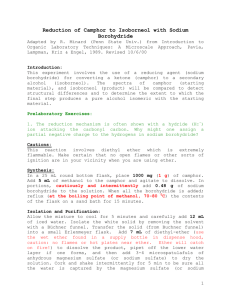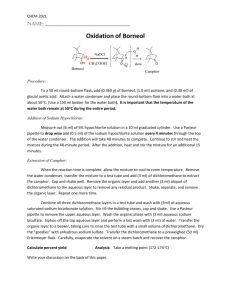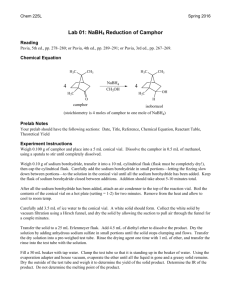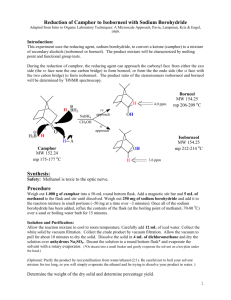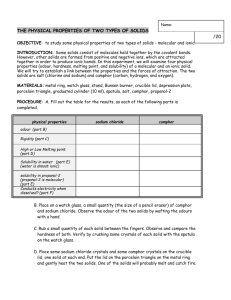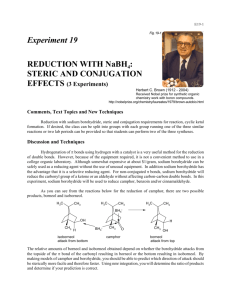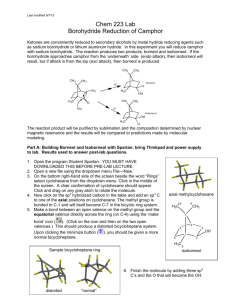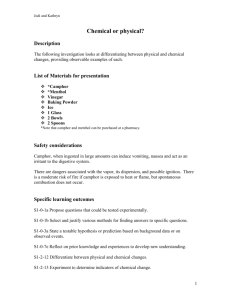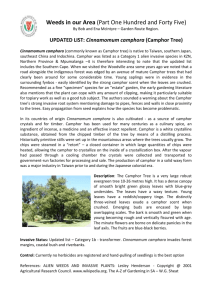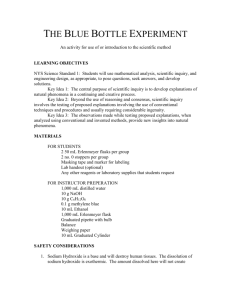An Oxidation-Reduction Scheme: Borneol, Camphor, Isoborneol1
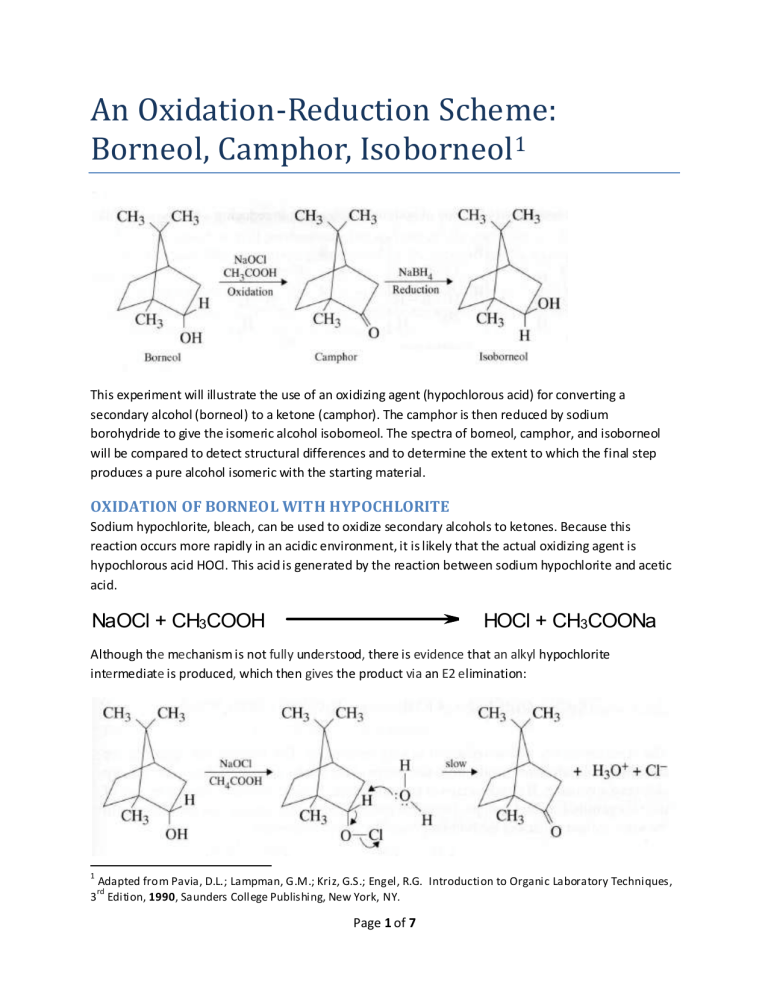
An Oxidation-Reduction Scheme:
Borneol, Camphor, Isoborneol
1
This experiment will illustrate the use of an oxidizing agent (hypochlorous acid) for converting a secondary alcohol (borneol) to a ketone (camphor). The camphor is then reduced by sodium borohydride to give the isomeric alcohol isoborneol. The spectra of borneol, camphor, and isoborneol will be compared to detect structural differences and to determine the extent to which the final step produces a pure alcohol isomeric with the starting material.
OXIDATION OF BORNEOL WITH HYPOCHLORITE
Sodium hypochlorite, bleach, can be used to oxidize secondary alcohols to ketones. Because this reaction occurs more rapidly in an acidic environment, it is likely that the actual oxidizing agent is hypochlorous acid HOCl. This acid is generated by the reaction between sodium hypochlorite and acetic acid.
NaOCl + CH
3
COOH HOCl + CH
3
COONa
Although th e m ec hanism is not fully und e r s tood , there is evidence that an alkyl hypochlorite int e rmediat e is produced , which then gives the product via an E2 e limination:
1
3
Adapted from Pavia, D.L.; Lampman, G.M.; Kriz, G.S.; Engel, R.G. Introduction to Organic Laboratory Techniques, rd
Edition, 1990 , Saunders College Publishing, New York, NY.
Page 1 of 7
REDUCTION OF CAMPHOR WITH SODIUM BOROHYDRIDE
Metal hydrides (sources of H:
-
) of the Group III elements, such a lithium aluminum hyride LiAlH4 and sodium borohydride NaBH4, are widely used in reducing carbonyl groups. Lithium aluminum hydride, for example, reduces many compounds containing carbonyl groups, such as aldehydes, ketones, carboxylic acids, esters, or amides, whereas sodium borohydride reduces only aldehydes and ketones. The reduced reactivity of borohydride allows it to be used even in alcohol and water solvents, whereas lithium aluminum hydride reacts violently with these solvents to produce hydrogen gas and thus must be used in nonhydroxylic solvents. In the present experiment, sodium borohydride is used be cause it is easily handled, and the results of reductions using either of the two reagents are essentially the same. The same care need not be taken in keeping sodium borohydride away from water as is required with lithium aluminum hydride.
The mechanism of action of sodium borohydride in reducing a ketone is as follows:
Note in this mechanism that all four hydrogen atoms are available as hydrides (H:
-
) , and thus one mole of borohydride can reduce four moles of ketones. All the steps are irreversible. Usually excess borohydride is used, because there is uncertainty regarding the purity of the material.
Once the final tetraalkoxyboron compound ( 1 ) is produced, it can be decomposed (along with excess borohydride) at elevated temperatures as shown:
(R
2
CH-O)
4
B Na + + 4 R'OH 4 R
2
CHOH + (R'O)
4
B Na +
The stereochemistry of the reduction is very interesting. The hydride can approach the camphor molecule more easily from the bottom side (endo approach) than from the top side (exo approach). If
Page 2 of 7
attack occurs at the top, a large steric repulsion is created by one of the two geminal methyl groups.
Geminal methyl groups are groups that are attached to the same carbon. Attack at the bottom avoids this steric interaction.
It is expected, therefore , that isoborneol, the alcohol produced from the attack at the least-hindered position, will predominate but will not be the exclusive product in the final reaction mixture. The percentage composition of the mixture can be determined by spectroscopy.
It is interesting to note that when the methyl groups are removed (as in 2-norbornanone), the top side
(exo approach) is favored , and the opposite stereochemical result is obtained. Again , the reaction does not give exclusively one product.
Bicyclic systems such as camphor and 2-norbornanone react predictably according to steric influences.
This effect has been termed steric approach control. In the reduction of simple acyclic and monocyclic
Page 3 of 7
ketones, however, the reaction seems to be influenced primarily by thermodynamic factors. This effect has been termed product development control. In the reduction of 4-t-butylcyclohexanone, the thermodynamically more stable product is produced by product development control.
SPECIAL INSTRUCTIONS
The reactants and products are all highly volatile and must be sto red in tightly clo sed containers. The re action should be carried out in a well-ventilated room or under a hood because a s mall amount of chlo rine gas will be emitted from the r eac tion mixture. The reduction of camphor to i sobo rneol involve s diethyl ether, which is extremely flammable. Be certain that no open flames of any so rt are in your vicin ity when you are u s ing ether.
WASTE DISPOSAL
The aqueous solutions obtained from the extraction steps should be placed in the aqueous waste container. Any leftover methanol or ether solution may be plac e d in the non-halogenated organic waste container.
Page 4 of 7
PROCEDURE
Part A. Oxidation of Borneol to Camphor
2
Assemble the Apparatus. To a 10-mL round-bottom flask add 0.360 g of racemic borneol , 1.0 mL of acetone , and 0.30 mL of glacial acetic acid. After adding a magnetic stir bar to the flask, attach an air condenser and place the round-bottom flask in a water bath at about 45 ° C. It is important that the temperature of the water bath remain between 40 and 50 ° C during the entire reaction period. Stir the mixture until the borneol is dissolved. If the borneol does not dissolve, add 0.50 m L of acetone.
Addition of Sodium Hypochlorite. While continuing to stir the reaction mi x ture , add dropwise 6.0 mL of a sodium hypochlorite (bleach) solution
3 through the top of the air condenser over a period of about 35 minutes. When the addition is complete, stir the mixture for an addi tional 15 minutes.
Extraction of Camphor. When the reaction time is complete , allow the mixture to cool to room temperature. Remove the air condenser , transfer the mixture to a screw-cap centrifuge tube , and add
2.0 mL of methylene chloride to extract the camphor . Cap the centrifuge tube and shake well, venting occasionally . Using a Pasteur pipet , transfer the lower methylene chloride layer into another centrifuge tube. Extract the aqueous layer with a second 2.0-mL portion of methylene chloride and combine it with the first methylene chloride solution.
Wash the combined methylene chloride layers with 2.0 mL of saturated sodium bicarbonate solution.
Stir the liquid with a stirring rod or spatula until bubbling produced by the formation of carbon dio x ide ceases. Cap the tube and shake with frequent venting to release any pressure produced. Transfer the lower methylene chloride layer to another container and remove the aqueous layer.
Return the methylene chloride layer to the centrifuge tube , and wash this solution with 2 .
0 mL of 5 % sodium bisulfite. Transfer the methylene chloride layer to another container , remove the aqueous layer , and return the methylene chloride layer to the tube. Wash the methylene chloride layer with 2.0 mL of water and remove the aqueous layer, as just described. Using a dr y Pasteur pipet , transfer the methylene chloride layer to a dry test tube or conical vial.
Isolation of Product. Add three to four microspatulafuls of granular anhydrous sodium sulfate and let the solution dry for 10-15 m i nutes , shaking it occasionally . ( Add more anhydrous sodium sulfate , if necessary, to remove all cloudiness.
) Weigh a 10-mL Erlenmeyer flask and transfer the methylene chloride to it. Evaporate the solvent in the hood with a gentle stream of dry air or nitrogen gas while heating the Erlenmeyer flask in a water bath at 40-50 ° C. When all the liquid has evaporated and a solid
2
This experiment also works well with swimming pool chlorine (calcium hypochlorite) as the oxidizing agent. The procedure for this variation may be found in the Instructor's Ma nual.
3
Note to the Instructor. W e use sodium hypochlorite (10-13%) from Aldrich Chemical Co. (Catalogue Number 42,
504-4). It should be stored in the refrigerator. Dilute this reagent with an equal volume of water for use in this experiment.
Page 5 of 7
has appeared , remo v e the flask from the heat source. As an alternative, leave the flask in the hood until the meth y lene chloride has evaporated.
4
Analysis of Camphor . Weigh the flask to determine the weight of your product and calculate the percentage yield. Determine the melting point; the melting point of pure racemic camphor is 174 ° C.
5
Save a small amount of the camphor for an infrared spectrum determination . The remainder of the camphor is reduced in the next step to isoborneol , which will be carried out in the same flask.
' Store the camphor with the flask tightly sealed until needed. Determine the infrared spectrum of camphor either as a KBr pellet or by the dry film method.
Part B. Reduction of Camphor to Isoborneol
Reduction. Reweigh the 10-mL Erlenmeyer flask to determine the weight of camphor remaining. If the amount is less than 0.100 g, obtain some camphor from the supply shelf to supplement your yield. If it is more than 0.100 g , scale up the reagents appropriately from the following amounts.
Add 0 .
5 mL of methanol to the camphor in the 10-mL Erlenmeyer flask. Stir with a glass stirring rod until the camphor has dissolved . In portions , cautiously and intermittently add 0 .
10 g of sodium borohydride to the solution.
6
( Replace the cap on the bottle of sodium boroh y dride immediately.) When all the borohydride is added, boil the contents of the flask on a steam bath or a warm hot plate ( low setting ) for 2 minutes .
Isolation and Analysis of Product. Allow the reaction mi x ture to cool for a couple of minutes , and carefully add 3 .
5 mL of ice water . Collect the white solid by filtering on a Hirsch funnel , and by using suction allow to dry for se v eral minutes . Transfer the solid to a 10 mL Erlenmeyer flask. Add 4.5 mL of ether to dissolve the product and three to four microspatulafuls of anhydrous magnesium sulfate to dry the solution. To remove the drying agent , filter the mixture with a filtering pipet into a 25-mL
Erlenmeyer flask that has been tared. Use another 1.0 mL of ether to rinse the 10-mL Erlenmeyer flask, and filter this . Evaporate the solvent in a hood, as described previously.
Determine the weight of the product, and calculate the percentage yield. Determine the melting point ; pure racemic isoborneol melts at 212 ° C. Determine the infrared spectrum of the product by the previous method.
4
If the crystals appear wet with solvent, apply a vacuum for a few seconds to get rid of residual solvent.
5
The observed melting point of camphor is often low. A small amount of impurity drastically reduces the melting point and increases the range.
6
Note to the Instructor: The sodium borohydride should be checked to see whether it is active. Place a small amount of powdered material in some methanol and heat it gently. The solution should bubble vigorously if the hydride is active.
Page 6 of 7
Part C. Percentages of Iso-borneol and Borneol Obtained from the Reduction of Camphor
The percentage of each of the isomeric alcohols in the borohydride reduction mixture can be determined from the NMR spectrum.
7
The hydrogen on the carbon bearing the hydroxyl group appears at 4.0 ppm for borneol and 3.6 ppm for isoborneol. To obtain the product ratio , integrate these peaks
(using an expanded presentation) in the NMR spectrum of isoborneol obtained after the borohydride reduction.
REFERENCES
Brown, H. c., and Muzzio, J. " Rates of Reaction of Sodium Borohydride with Bicyclic Ketones.
" Journal of the American Chemical Society, 88 (1966): 2811.
Dauben, W. G., Fonken, G. J.
, and Noyce, D. S. "Stereochemistry of Hydride Reductions." Journal of the
American Chemical Society , 78 (1956): 2579.
Flautt, T. J.
, and Erman, W. F. " The Nuclear Magnetic Resonance Spectra and Stereochemistry of
Substituted Boranes.
" Journal of the American Chemical Society , 85 (1963): 3212.
Markgraf , J. H. " Stereochemical Correlations in the Camphor Series." Journal of Chemical Education, 44
(1967): 36.
Mohrig,J.R., Nienhuis, C. F., Van Zoeren, c., Fox, B. G., and Mahaffy, P. G. "The Design of Laboratory
Experiments in the 1980 ' s." Journal of Chemical Education, 62 (1985): 519.
7
Approximate percentages can also be obtained by gas chromatography, using a Gow-Mac 69-360 instrument. Use an 8-foot column of 10% Carbowax 20M and operate the device at 180°C with a 40-mL/min flow rate. The compounds are dissolved in methylene chloride for analysis. The retention times for camphor, isoborneol, and borneol are 8, 10, and 11 minutes, respectivel y.
Page 7 of 7
